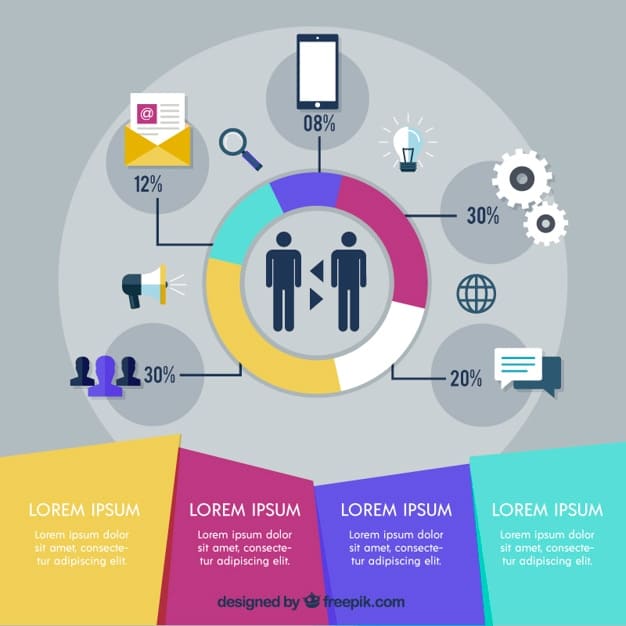Data Analytics: Why It’s Vital for Informed Business Decisions

Data analytics is crucial for businesses because it transforms raw data into actionable insights, enabling informed decision-making, strategic planning, and improved overall performance, driving growth and maintaining a competitive edge in today’s market.
In today’s fast-paced business environment, making informed decisions is crucial for success. Data analytics provides the tools and insights needed to transform raw data into actionable strategies, enabling businesses to optimize their operations and achieve their goals.
Understanding data analytics and its significance
Data analytics involves examining raw data to draw conclusions about that information. It employs various techniques and processes to uncover hidden patterns, correlations, and insights. Understanding its significance requires recognizing how it transforms business operations.
What constitutes data analytics?
Data analytics encompasses a wide range of activities, from simple descriptive statistics to complex predictive modeling. It includes data mining, statistical analysis, data visualization, and machine learning.
Why is data analytics essential?
Data analytics is essential because it provides businesses with the knowledge they need to make better decisions. It helps identify opportunities, mitigate risks, and improve overall performance.
- 📊 Enables informed decision-making by providing actionable insights.
- 📈 Improves strategic planning by identifying trends and patterns.
- 🛡️ Mitigates risks by uncovering potential problems early.
- 💰 Optimizes operations by identifying areas for cost reduction and efficiency improvements.
In sum, understanding data analytics is paramount for any business seeking to thrive in a data-driven world. By employing the right techniques and tools, organizations can unlock the full potential of their data and gain a competitive advantage.

The role of data in strategic business decisions
Data plays a pivotal role in shaping strategic business decisions. By leveraging data analytics, companies can move beyond guesswork and rely on concrete evidence to guide their actions. This approach leads to more effective strategies and better outcomes.
Data-driven decision-making
Data-driven decision-making involves using data analytics to inform every aspect of the decision-making process. From identifying problems to evaluating potential solutions, data provides a solid foundation for making choices.
Developing strategic plans with data
Strategic plans developed with data analytics are more likely to succeed because they are based on real-world evidence rather than assumptions. Data helps companies identify opportunities, assess risks, and allocate resources effectively.
- 🔍 Identify market trends and opportunities.
- 🎯 Set realistic and achievable goals.
- 💸 Allocate resources efficiently based on data insights.
- 📈 Evaluate the effectiveness of strategic initiatives.
In conclusion, the role of data in strategic business decisions cannot be overstated. By embracing data-driven approaches, businesses can make more informed choices, develop more effective strategies, and achieve better results.
Analyzing market trends and consumer behavior
Analyzing market trends and consumer behavior is a critical aspect of modern business. Data analytics provides the tools needed to understand these dynamics, enabling companies to adapt quickly and stay ahead of the competition. This involves gathering and processing data from various sources to gain insights into customer preferences and market changes.
Utilizing data to understand market dynamics
Data analytics helps businesses understand market dynamics by identifying patterns and trends in sales, pricing, and competition. This information can be used to make better decisions about product development, marketing, and sales strategies.
Understanding consumer preferences and behavior
By analyzing consumer data, companies can gain valuable insights into customer preferences and behavior. This includes understanding what products and services customers want, how they make purchasing decisions, and what influences their loyalty.

Understanding consumer preferences and behavior is key to creating effective marketing strategies. By analyzing demographic data, purchase history, and online activity, companies can tailor their messaging and offers to specific customer segments.
- 🛍️ Identifying patterns in purchasing behavior.
- 💬 Analyzing customer feedback and reviews.
- 🌐 Monitoring social media trends and sentiment.
- 📊 Tracking website traffic and engagement metrics.
In summary, analyzing market trends and consumer behavior through data analytics enables businesses to make more informed decisions. This leads to better product development, more effective marketing, and increased customer satisfaction.
Enhancing operational efficiency through data insights
Enhancing operational efficiency is a key goal for many businesses, and data insights play a crucial role in achieving this. By analyzing data from various operational processes, companies can identify bottlenecks, inefficiencies, and areas for improvement. This leads to streamlined operations and better resource utilization.
Identifying inefficiencies in business processes
Data analytics can help businesses identify inefficiencies in their processes by analyzing data related to production, supply chain, and customer service. This information can be used to streamline workflows and reduce costs.
Optimizing resource allocation
Optimizing resource allocation involves using data to make better decisions about how to allocate resources such as budget, staff, and equipment. By analyzing data on performance and demand, companies can ensure that resources are used effectively.
- 🔄 Streamlining workflows to reduce redundancies.
- ⚙️ Automating tasks to improve productivity.
- 📦 Optimizing supply chain management to reduce costs.
- 👥 Better allocation of employees based on efficiency data.
In conclusion, enhancing operational efficiency through data insights leads to significant improvements in performance and profitability. By embracing a data-driven approach to operations, businesses can achieve greater efficiency and competitiveness.
Risk management and mitigation using data analytics
Risk management and mitigation are essential for protecting businesses from potential threats. Data analytics provides powerful tools for identifying, assessing, and mitigating risks across various areas of the organization. This leads to better risk management and increased resilience.
Identifying potential risks before they occur
Data analytics helps businesses identify potential risks before they occur by analyzing historical data, market trends, and other relevant information. This allows companies to take proactive steps to mitigate these risks and prevent negative outcomes.
Developing strategies for risk mitigation
By understanding the nature and likelihood of different risks, companies can develop targeted strategies for risk mitigation. This includes implementing controls, developing contingency plans, and purchasing insurance.
Risk mitigation strategies can be significantly enhanced by data analytics, allowing for more accurate and timely responses to potential threats. This helps maintain business continuity and protect shareholder value.
- 🚨 Proactively identifying potential threats and vulnerabilities.
- 📉 Assessing the likelihood and impact of different risks.
- 🛡️ Implementing controls to reduce exposure to risks.
- 📝 Developing contingency plans to respond to adverse events.
In sum, risk management and mitigation through data analytics are vital for ensuring the long-term success and stability of businesses. By embracing a data-driven approach to risk management, organizations can be better prepared to face challenges and seize opportunities.
Case studies of successful data analytics implementations
Examining case studies of successful data analytics implementations provides valuable insights into how businesses can leverage data to achieve their goals. These examples demonstrate the power of data analytics across various industries and functions, from improving customer satisfaction to optimizing supply chains.
Examples of companies that have benefited from data analytics
Many companies have benefited from data analytics, including retailers, manufacturers, and financial institutions. These organizations have used data to improve their operations, increase their revenue, and reduce their costs.
Lessons learned from these implementations
The lessons learned from successful data analytics implementations include the importance of having clear goals, investing in the right tools and technologies, and building a data-driven culture. It also highlights the need for skilled data analysts and strong leadership support.
Analyzing case studies reveals that the key to successful data analytics is aligning data strategies with business objectives. This ensures that data insights are relevant and actionable, leading to tangible improvements in performance.
- 📈 Increased revenue through targeted marketing campaigns.
- 💰 Reduced costs through optimized supply chain management.
- 😊 Improved customer satisfaction through personalized service.
In conclusion, analyzing case studies of successful data analytics implementations provides valuable lessons for businesses looking to leverage data to achieve their goals. These examples demonstrate the power of data analytics and the importance of adopting a data-driven approach.
Future trends in data analytics
Staying informed about future trends in data analytics is crucial for businesses that want to maintain a competitive edge. Emerging technologies and techniques are constantly reshaping the field, offering new opportunities to unlock insights and drive innovation. This involves understanding upcoming developments and preparing for their integration into business practices.
Emerging technologies and techniques
Emerging technologies in data analytics include artificial intelligence (AI), machine learning (ML), and big data platforms. These technologies enable businesses to process and analyze large volumes of data more efficiently and effectively.
Preparing for the future of data-driven decision-making
Preparing for the future of data-driven decision-making involves investing in training and development for data analysts, building a data-driven culture, and adopting new technologies. It also requires developing strategies for data governance and security.
Preparing for future trends involves embracing continuous learning and adaptation. As data analytics evolves, businesses need to stay agile and be ready to incorporate new tools and methodologies into their operations.
- 🤖 Adoption of artificial intelligence and machine learning.
- ☁️ Increased use of cloud-based data platforms.
- 🔐 Focus on data governance and security.
In summary, understanding and preparing for future trends in data analytics is essential for businesses that want to remain competitive. By embracing new technologies and techniques, organizations can unlock new insights and drive innovation.
| Key Point | Brief Description |
|---|---|
| 📊 Strategic Decisions | Data analytics informs effective strategic plans. |
| 📈 Market Trends | It helps analyze market dynamics and consumer behavior. |
| ⚙️ Operational Efficiency | Enhances processes and optimizes resource allocation. |
| 🛡️ Risk Management | Mitigates risks through data-driven strategies. |
Frequently Asked Questions
▼
The primary goal is to transform raw data into actionable insights that support informed decision-making, strategic planning, and overall business improvement, driving growth and efficiency.
▼
Data analytics identifies inefficiencies by analyzing production, supply chain, and customer service data, streamlining workflows and reducing costs to optimize resource allocation.
▼
It helps businesses understand dynamics by identifying patterns and trends in sales, pricing, and competition, crucial for product development and marketing strategies.
▼
Yes, it identifies potential risks by analyzing historical data and market trends, enabling proactive steps to mitigate risks and prevent negative outcomes through targeted strategies.
▼
Trends to watch include AI, machine learning, and cloud-based platforms, which enable efficient processing of large data volumes, requiring businesses to invest in data governance and security.
Conclusion
In summary, data analytics is an indispensable tool for businesses aiming to make informed decisions and achieve sustainable growth. By leveraging data-driven insights, organizations can optimize their operations, enhance strategic planning, and stay ahead in today’s competitive landscape, ensuring long-term success and resilience.